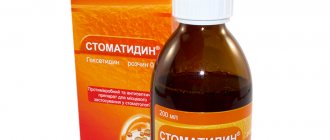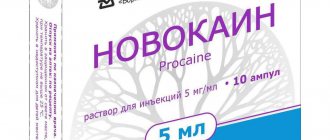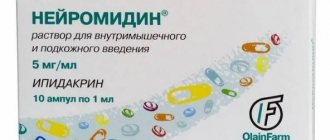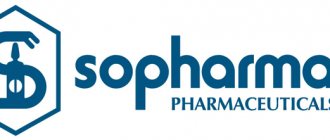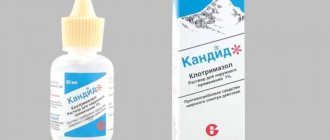- October 21, 2018
- Other drugs
- Inna Makagon
"Novocaine" is an anesthetic drug for local use, has a wide spectrum of action.
It has a positive effect on the condition of nerve cells and eliminates pain impulses. Effectively fights spasms of smooth muscles, reduces the excitability of the motor zones of the cerebral cortex and heart muscles. In addition, it eliminates the body’s polysynaptic reactions to stimuli and inhibitory effects on the brain stem.
Pharmacological authorities
Pharmacodynamics.
Novocaine is a local anesthetic drug with moderate activity and a wide range of therapeutic effects. The mechanism of anesthetic action is due to the blockade of sodium channels, galvanization of potassium current, competition with calcium of the surface tension of the phospholipid ball of membranes, suppression of oxide-based processes and pulse generation. When present in the blood, it changes the level of acetylcholine, reduces the irritability of peripheral cholinergic systems, exhibits a blocking effect on the autonomic ganglia, changes smooth muscle spasms, reduces the irritability of the cardiac muscle and motor these are areas of measles cerebrospinal fluid.
Pharmacokinetics.
When administered parenterally, the drug is absorbed. The level of absorption depends on the site and route of administration (especially in terms of vascularization and fluidity of blood flow at the site of administration) and subdoses (amount and concentration of dose). Liquid is hydrolyzed by esterases and cholesterases in plasma and tissues with the release of two main pharmacologically active metabolites: dietylaminothanol (may have a mild vasodilatory effect) and para-aminobenzoic acid (competitive antagonist). use of sulfonamide chemotherapy drugs and may weaken their antimicrobial action). The learning period is 30–50 seconds, for the neonatal period it is 54–114 seconds. There are significant differences in the appearance of metabolites (80%); In an unchanged appearance, no more than 2% is displayed. Poorly absorbed through the mucous membranes.
What is the solution used for?
According to the instructions, Novocain 2 percent is prescribed for the following conditions and diseases:
- When carrying out various operations.
- Novocaine blockades (administration of the drug “Novocaine” or another anesthetic to the site of pain localization).
- Sciatica (an illness that is caused by pinching of the sciatic nerve, the presence of an inflammatory process in the lower back).
- Neurodermatitis (skin disease of the neurogenic-allergic type, which occurs with remissions and exacerbations).
In addition to these indications, the drug is also prescribed for the following ailments:
- Eczema (inflammatory lesion of the skin, which is characterized by various rashes, burning sensations, itching and a tendency to recur).
- Spasms of peripheral vessels.
- Frostbite (damage to body tissues caused by cold).
- Performing novocaine blockades.
- Infiltration anesthesia (local anesthesia, when the tissues are saturated with an anesthetic substance, and it blocks the nerve impulses that tell the brain about pain).
According to reviews, Novocain 2% is prescribed for menopause for 10 days. The drug is used orally to increase the dosage and then decrease it. During this time, approximately thirty two-milliliter ampoules are used.
Contraindicated
Increased sensitivity to novocaine; cardiogenic shock; arterial hypotension is pronounced; severe forms of chronic heart failure; decreased function of the left sac; atrioventricular block stage II–III; severe bradycardia; Adams-Stokes syndrome; history of ship attacks caused by novocaine; sick sinus syndrome; severely impaired liver function; hypovolemia; bleeding; myasthenia; Infection of the site of lumbar puncture; septicemia; putrefactive process at the site of administration of medicinal treatment; terminological surgical procedures that are accompanied by acute bleeding. In case of glaucoma, it is prohibited to administer the drug retrobulbarly.
What contraindications does the drug have?
According to the instructions for use, Novocaine 2% is prohibited for the following diseases:
- Fibrosis (a disease that is characterized by an accelerated process of collagen production and the proliferation of connective tissue in any organs of the body due to inflammation).
- Hypotension (decreased blood pressure).
- Bleeding (outflow of blood beyond the vascular bed or heart into the environment, into the body cavity or the lumen of a hollow organ).
- Septicemia (a type of blood poisoning in which there is a disturbance in the general condition of the body due to inflammation that has arisen in it, but there are no areas of purulent damage to internal organs).
- Shock (a pathology that develops in response to exposure to extreme irritants and is accompanied by a progressive disruption of the vital functions of the nervous system, blood circulation, respiration, metabolism and some other functions).
- Increased sensitivity to novocaine.
The drug is prescribed with extreme caution for the following conditions:
- Acute blood loss (pathology that occurs as a result of severe bleeding or as a result of blood donation).
- Cardiovascular failure (syndrome caused by decompensated myocardial dysfunction).
- Liver failure (a set of symptoms characterized by a violation of one or more liver functions, resulting from damage to its parenchyma).
- Inflammatory diseases (generalized name for a complex, local or general pathological process that occurs in response to damage to the cellular structures of the body).
- Congestion in the liver.
- Abscess at the injection site.
Careful therapeutic monitoring requires the use of the drug by children under eighteen years of age, people of retirement age, and women during childbirth.
Interactions with other medicinal drugs and other types of interactions
Procaine prolongs the nerve-muscle blockade caused by suxamethonium (remnants of the offending drug are hydrolyzed by plasma cholesterase).
Simultaneous treatment with monoamine oxidase inhibitors (furazolidone, procarbazine, selegiline) promotes the development of arterial hypotension.
The toxicity of the drug is promoted by anticholinesterase drugs (suppressing its hydrolysis). The drug changes the infusion of anticholinesterase drugs into nerve-meat transmission.
The metabolite of procaine (para-aminobenzoic acid) is a competitive antagonist of sulfonamide drugs and may weaken its antimicrobial action.
Oversensitization is possible.
Internal administration of novocaine has the potential to produce anesthesia. When treating the area with a medicinal disinfectant to remove important metals, there is a risk of developing a local reaction in the form of pain and swelling.
Potential for direct anticoagulants.
What other negative reactions can Novocain cause?
If the drug is used incorrectly, the following negative conditions occur:
- Bradycardia (a type of sinus rhythm disorder that is controlled by the sinus node).
- Paralysis of the lower extremities (loss of motor abilities caused by damage to the spinal cord).
- Collapse (a life-threatening condition characterized by a drop in blood pressure and deterioration of organ microcirculation).
- Blood pressure surges.
- Arrhythmia (a pathological condition leading to a disturbance in the frequency, rhythm and sequence of excitation and contraction of the heart).
- Encopresis (involuntary loss of control over bowel movements)
- Skin rashes.
- Hypothermia (a condition of the body in which the body temperature drops below that required to maintain normal metabolism and function).
- Impotence (sexual dysfunction, weakening or absence of erection).
Features of good stagnation
Skin tests with local anesthetics should be performed in individuals with little evidence of response to these medications. Particular attention is needed when testing local anesthetics to replace adrenaline, through increasing the frequency of hyphen-negative reactions. It is recommended to carry out provocative tests in order to counteract the negative results of skin tests. Testing of patients with known allergic reactions to local anesthetics can be carried out only by allergists who may have evidence of drug allergies.
Novocaine can only be administered by healthcare professionals.
- When performing local anesthesia of tissues with significant vascularization (for example, during surgery on the thyroid gland), special care should be taken to avoid wasting the drug in the trial.
- Smaller doses of the drug should be administered into the head and neck area, including retrobulbar and dental administration, as well as infusion to block the optic ganglion, as there may be systemic toxic effects through retrograde penetration of the drug into the head and neck. cerebral blood circulation
- The safety of administration of anesthetics of the amide group is questionable in patients susceptible to malignant hyperthermia, therefore their administration in such episodes is unique.
- Care must be taken to avoid episodic subdural or intravasal administration of the drug. It is necessary to establish close control over the systemic toxic effect of the drug on the cardiovascular and central nervous systems (some doses indicated for epidural anesthesia are generally lower for subdural anesthesia).
- Extreme care must be taken when administering anesthesia to the spinal cord in patients with neurological illnesses, spinal deformation, septicemia and severe arterial hypertension.
- Before taking Novocaine for heart disease (hypokalemia reduces the effectiveness of Novocaine), it is necessary to normalize the level of potassium in the blood.
- Particular care should be taken when taking novocaine in patients with insufficiency of blood flow, hypovolemia, arterial hypotension, hepatic and nitric insufficiency. Caution should also be exercised when administering novocaine to patients of the summer age (over 65 years of age), those suffering from epilepsy, with damaged conductivity of the heart, with respiratory failure, or pseudocholesterol deficiency. nesterazi, seriously ill, weakly ill, in the period of pregnancy or breastfeeding, at the end of the day.
- To reduce systemic activity, toxicity and prolong the effect during local anesthesia, use novocaine in combination with vasoconstrictors.
Suspension during pregnancy or breastfeeding.
Stagnation during the period of pregnancy is possible as long as it is well tolerated.
During the period of breastfeeding, a medicinal solution is possible after a preliminary reactive assessment of the clinical course of therapy for the mother and the potential risk of pregnancy.
When the curtains are left standing under the curtains, bradycardia, apnea, and development in the newborn may develop.
This is due to the fluidity of the reaction during treatment with vehicles or other mechanisms.
During the treatment period, you should avoid using motor vehicles and other potentially unsafe types of activities that will require increased concentration and speed of psychomotor reactions, in connection with the possibility There are some adverse reactions on the part of the nervous system, sensitive organs and/or the cardiovascular system ( div. section “Adverse reactions”).
Method of congestion and dosage
The dosage of the drug should depend on the type of anesthesia, the stage of tissue vascularization, the required depth and severity of pain treatment, as well as the individual characteristics of the patient. Next, administer the lowest effective dose.
Recommended doses:
| Type of anesthesia | Novocaine (procaine hydrochloride) | ||
| Rozchin concentration, % | Dispense volume, ml | Novocaine dose, mg | |
| Mandibular | 2 | 2–3 | 40–60 |
| Infraorbital | 2 | 0,5–1 | 10–20 |
| Painful fingers (without adrenaline) | 1* | 3–4 | 30–40 |
| Paracervical (in the eyes of the elderly 5-line injections) | 1* | 3 (skin has 4 sections) | 80–120 |
*To extract a 1% solution of novocaine, use a sterile 0.9% solution of sodium chloride.
To carry out caudal and lumbar epidural blockade, 15–25 ml of 2% resin is administered. The maximum volume of a single injection should not exceed 25 ml. Repeated doses, which amount to smaller doses of 2–6 ml, are administered at intervals of 40–50 days.
The maximum single dose for adults is 11 mg/kg body weight, and not more than the maximum daily dose of 800 mg. Dosage changes for special age patients, weakened patients and patients with cardiovascular and/or hepatic illness (div. also section “Peculiarities of congestion”).
Children.
The medical treatment for children is blocked.
Overdose
Overdose is possible only with high doses of novocaine.
Symptoms:
paleness of the skin and mucous membranes, confusion, fatigue, vomiting, increased nervousness, “cold” sweat, tachycardia, decreased arterial pressure to the point of collapse, tremor, seizures, apnea, methemoglobinemia I am depressed, depressed, rapt’s heart-judicial collapse.
The influx into the central nervous system manifests itself as fear, hallucinations, seizures, and nervous awakenings.
Likuvannya.
In cases of overdose, the administration of the drug must be carefully taken. When performing local anesthesia, the injection site can be injected with adrenaline.
Outpatient resuscitation visits: acid inhalation, and, if necessary, individual ventilation of the lungs. If the symptoms last for more than 15–20 seconds, their aftermath should be stopped with internal administration of thiopental (100–150 mg) or diazepam (5–20 mg). In case of arterial hypotension and/or myocardial depression, ephedrine (15–30 mg) is administered internally; in severe cases, detoxification and symptomatic therapy is used.
If intoxication develops after injection into the leg or arm, a tourniquet will be applied to reduce further penetration of the drug into the bloodstream.
Adverse reactions
After consuming Novocaine, the following may appear:
- Migraines (a neurological disease, the most common and characteristic symptom of which is episodic or regular severe pain).
- Cramps (muscle contraction following overexertion).
- Drowsiness (a sleep disorder accompanied by a constant or periodic desire to fall asleep at a time not intended for sleep).
- Dizziness (a symptom that can occur with a large number of pathologies of different organs and systems).
- Syncope (temporary loss of consciousness, accompanied by loss of postural tone, caused by a short-term decrease in blood supply to the brain).
- Weaknesses.
- Nystagmus (automatic flickering eye movements of high frequency).
- Tremors (fast, rhythmic movements of the limbs or trunk, caused by muscle contractions and associated with a temporary delay in corrective afferent signals).
- Paresthesia (one of the types of sensitivity disorders, which is characterized by sudden sensations of burning, tingling, and crawling).
Side effects
Medicinal treatment should be well tolerated, however, there may be a possibility of side effects.
From the side of the organs one can feel:
visual and hearing impairment, decreased visual acuity, ear noise, photophobia, nystagmus.
On the side of the scolio-intestinal tract:
tediousness, vomiting, fleeting defecation.
On the side of the thyroid system:
fleeting sechovypuskannaya.
On the side of the nervous system:
headache, restlessness, increased fatigue, confusion, drowsiness, weakness, loss of fluidity, seizures, trismus, tremor, cauda equine syndrome (leg paralysis, paresthesias), tongue and tongue degeneration ї plots, suppressed breathing, paralysis of respiratory sores, block motor and sensory, reversible pain, persistent anesthesia, coma.
On the side of the cardiovascular system:
chest pain, swelling or decreased arterial pressure, collapse, peripheral vasodilation, decreased cardiac output, bradycardia, arrhythmias, heart block, cardiac arrest.
On the side of the blood and lymphatic system:
Methemoglobinemia.
On the side of the immune system:
hypersensitivity reactions, including angioedema (including swelling of the larynx), other anaphylactic reactions (including anaphylactic shock), urticaria (on the skin and mucous membranes).
From the side of the skin and under the skin:
skin itching, skin rash, dermatitis, peeling skin, eczema, erythema, hyperemia.
Zagalni discord:
hypothermia, increased sweating, back pain.
Reactions at the injection site:
When treating the area with medicinal disinfectants to remove important metals, there is a risk of developing a local reaction in the form of pain and swelling.
Information about suspected adverse reactions.
Reporting suspected adverse reactions after drug registration is an important procedure. This allows for monitoring of the “measles/risk” relationship for a specific patient. Healthcare professionals are responsible for reporting any suspected adverse reactions through the national reporting system.
Overdose
Symptoms of poisoning:
- Dizziness (a symptom that can occur with a large number of pathologies of different organs and systems).
- Vomiting.
- Pins and needles sensation around the mouth.
- Tachycardia (increased heart rate).
- Collapse (a life-threatening condition characterized by a drop in blood pressure and a deterioration in blood flow to vital organs).
- Apnea (a pathology that is caused by an etiological factor that leads to temporary cessation of breathing during sleep).
- Methemoglobinemia (a disease in which there is an increase in the level of methemoglobin or oxidized hemoglobin in the main biological fluid of a person).
- A feeling of fear (a state that is caused by a threatening real or perceived disaster).
- Hallucinations (an image that appears in the mind without an external stimulus).
- Cramps.
- Motor agitation (a pathological condition characterized by motor restlessness of varying severity).

